完整版英语人教版八年级下册第六单元教学设计
- 格式:doc
- 大小:15.03 KB
- 文档页数:5


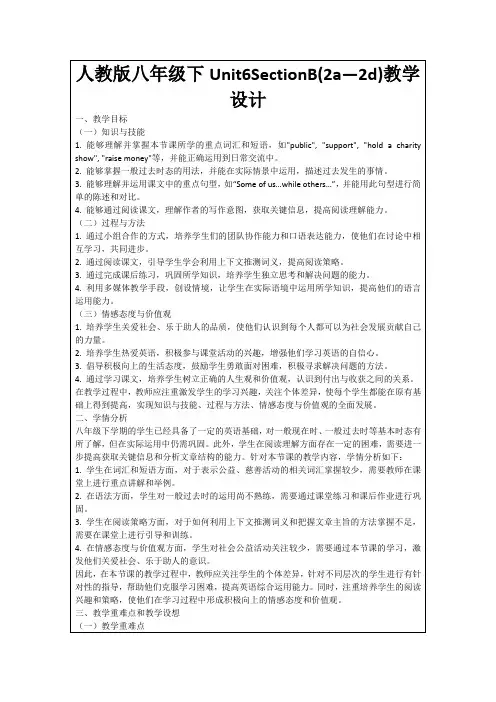
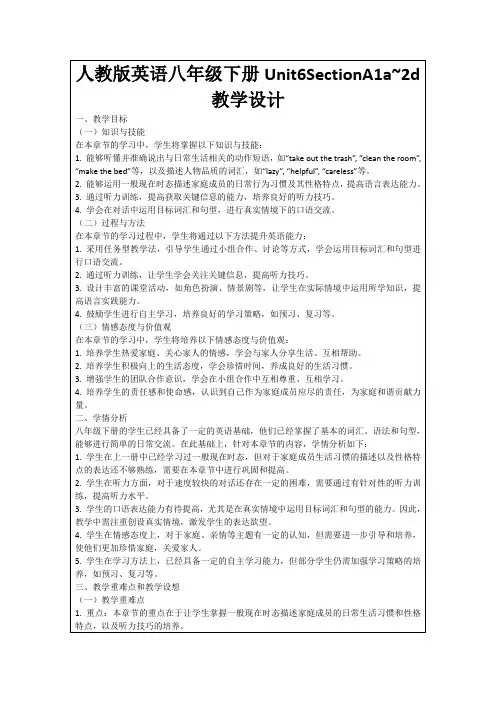
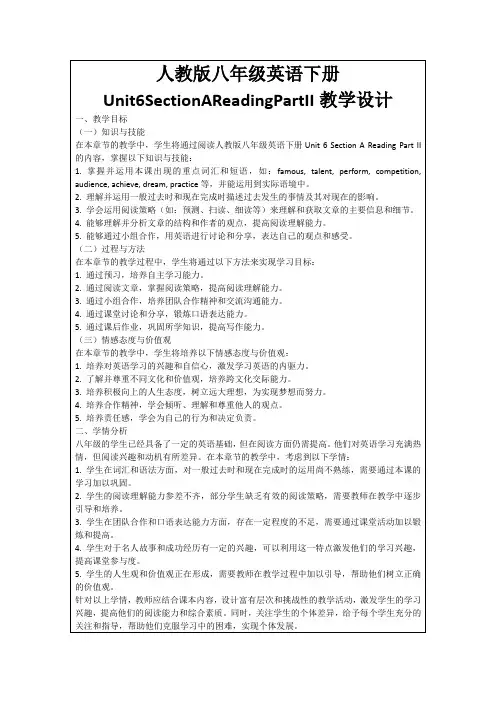
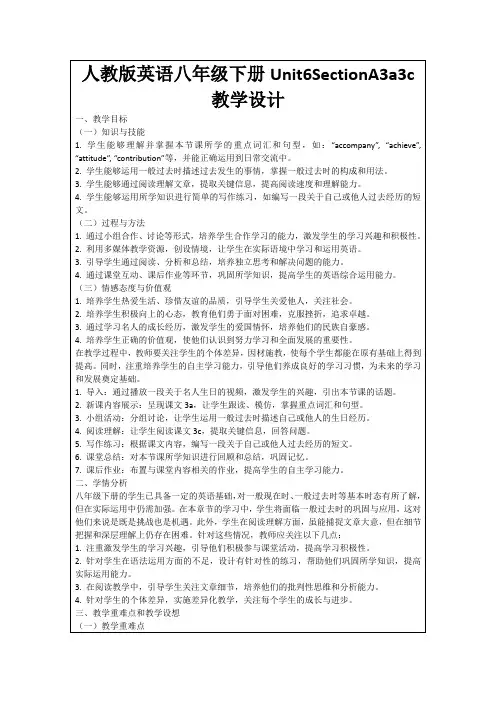
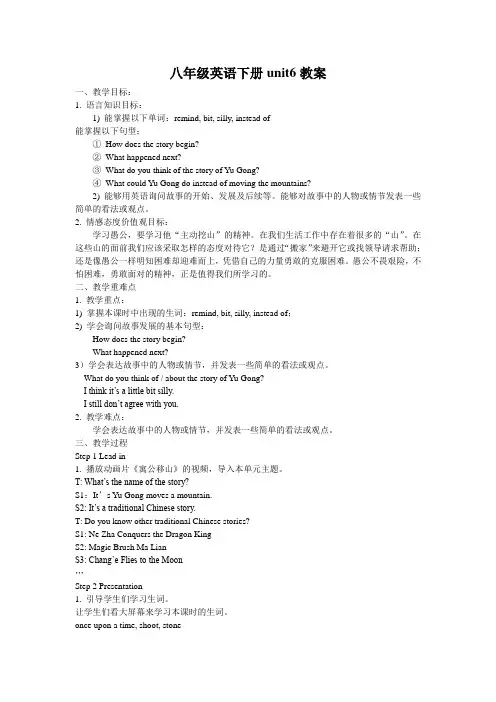
八年级英语下册unit6教案一、教学目标:1. 语言知识目标:1) 能掌握以下单词:remind, bit, silly, instead of能掌握以下句型:①How does the story begin?②What happened next?③What do you think of the story of Yu Gong?④What could Yu Gong do instead of moving the mountains?2) 能够用英语询问故事的开始、发展及后续等。
能够对故事中的人物或情节发表一些简单的看法或观点。
2. 情感态度价值观目标:学习愚公,要学习他“主动挖山”的精神。
在我们生活工作中存在着很多的“山”。
在这些山的面前我们应该采取怎样的态度对待它?是通过“搬家”来避开它或找领导请求帮助;还是像愚公一样明知困难却迎难而上,凭借自己的力量勇敢的克服困难。
愚公不畏艰险,不怕困难,勇敢面对的精神,正是值得我们所学习的。
二、教学重难点1. 教学重点:1) 掌握本课时中出现的生词:remind, bit, silly, instead of;2) 学会询问故事发展的基本句型:How does the story begin?What happened next?3)学会表达故事中的人物或情节,并发表一些简单的看法或观点。
What do you think of / about the story of Yu Gong?I think it’s a little bit silly.I still don’t agree with you.2. 教学难点:学会表达故事中的人物或情节,并发表一些简单的看法或观点。
三、教学过程Step 1 Lead in1. 播放动画片《寓公移山》的视频,导入本单元主题。
T: What’s the name of the story?S1:It’s Yu Gong moves a mountain.S2: It’s a traditional Chinese story.T: Do you know other traditional Chinese stories?S1: Ne Zha Conquers the Dragon KingS2: Magic Brush Ma LianS3: Chang’e Flies to the Moon…Step 2 Presentation1. 引导学生们学习生词。
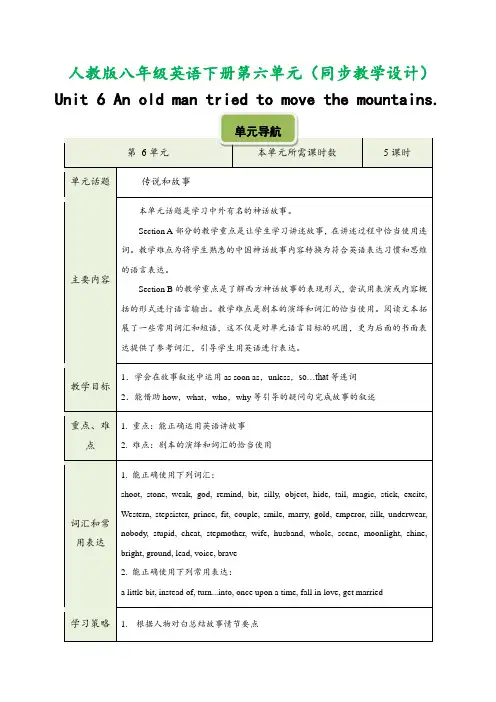
人教版八年级英语下册第六单元(同步教学设计)Unit 6 An old man tried to move the mountains.Unit 6 An old man tried to move the mountains.Unit 6 An old man tried to move the mountains.Unit 6 An old man tried to move the mountains.1.Show a picture of The Emperor’s New Clothes.T: Look at the picture, what’s the story?Ss: The Emperor’s New Clothes.…2. Teach the new words.Step 3 Practice1. Look at 1a. Match the words with the letters in the pictures in 1c.2. Check the answers.Answers: b gold c silk d emperora underwearStep 4 listening (1b & 1c)Work on 1b1. Listen for the first time to number the pictures [15] in 1c2. Check the answers.Answers (from top to bottom, from left to right): 4 3 2 5 1 Work on 1c1.Listen again. Let Ss fill in the blanks.2.Check the answers.Answers: looked, saw; shouted, wearing; give, kept; clothes; brothers3. Listen for the third time and try to answer the questions.Unit 6 An old man tried to move the mountains.Unit 6 An old man tried to move the mountains.Unit 6 An old man tried to move the mountains.老师在上课前,播放一段视频,向学生提出问题,通过对话引入本课时主题,导入新课。
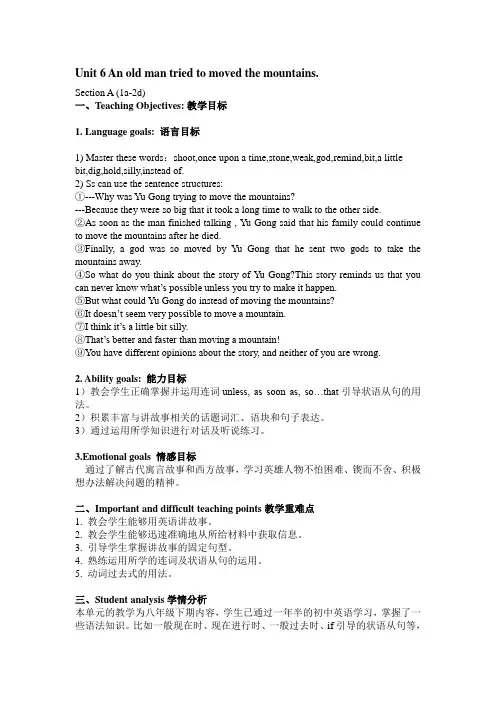
Unit 6 An old man tried to moved the mountains.Section A (1a-2d)一、Teaching Objectives: 教学目标1. Language goals: 语言目标1) Master these words:shoot,once upon a time,stone,weak,god,remind,bit,a little bit,dig,hold,silly,instead of.2) Ss can use the sentence structures:①---Why was Yu Gong trying to move the mountains?---Because they were so big that it took a long time to walk to the other side.②As soon as the man finished talking , Yu Gong said that his family could continue to move the mountains after he died.③Finally, a god was so moved by Yu Gong that he sent two gods to take the mountains away.④So what do you think about the story of Yu Gong?This story reminds us that you can never know what’s possible unless you try to make it happen.⑤But what could Yu Gong do instead of moving the mountains?⑥It doesn’t seem very possible to move a mountain.⑦I think it’s a little bit silly.⑧That’s better and faster than moving a mountain!⑨You have different opinions about the story, and neither of you are wrong.2. Ability goals: 能力目标1)教会学生正确掌握并运用连词unless, as soon as, so…that引导状语从句的用法。
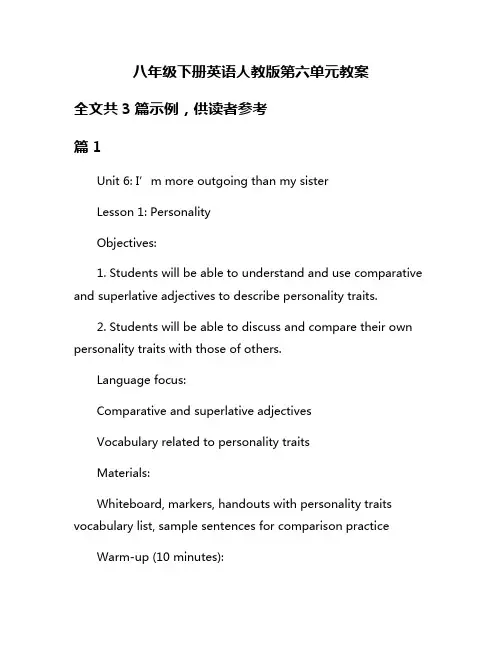
八年级下册英语人教版第六单元教案全文共3篇示例,供读者参考篇1Unit 6: I’m more outgoing than my sisterLesson 1: PersonalityObjectives:1. Students will be able to understand and use comparative and superlative adjectives to describe personality traits.2. Students will be able to discuss and compare their own personality traits with those of others.Language focus:Comparative and superlative adjectivesVocabulary related to personality traitsMaterials:Whiteboard, markers, handouts with personality traits vocabulary list, sample sentences for comparison practiceWarm-up (10 minutes):Begin the lesson by asking students to brainstorm as many adjectives as they can think of to describe personality traits. Write these adjectives on the board and discuss their meanings. Introduce the concept of comparative and superlative adjectives by explaining that they are used to compare two or more things. Provide examples using the adjectives already listed on the board.Presentation (15 minutes):Introduce the new vocabulary related to personality traits by giving students a handout with a list of words and their definitions. Have students practice pronouncing the words and understanding their meanings.Practice (20 minutes):Divide the class into pairs or small groups and give each group a set of cards with sentences using comparative and superlative adjectives. Students must match the sentences with the correct adjectives and discuss their meanings. Encourage students to form their own sentences using the adjectives in the cards.Production (15 minutes):Ask students to write a short paragraph comparing themselves with a family member or friend. They should use comparative and superlative adjectives to describe their personality traits. Encourage them to share their paragraphs with the class.Wrap-up (5 minutes):Review the key points of the lesson by asking students to give examples of comparative and superlative adjectives they used in their paragraphs. Assign homework that involves creating a poster with personality traits adjectives and their comparisons.Assessment:Monitor students during the production task to assess their understanding of comparative and superlative adjectives. Evaluate their participation in group discussions and their ability to use the vocabulary in context.篇2Unit 6: Could you please tell me where the restrooms are?Subject: EnglishGrade: 8thBackground Information:- This unit is focused on giving and asking for directions in English.- Students will learn vocabulary related to places in a city (e.g. bank, hotel, post office, etc.)- They will also practice using prepositions of place (e.g. next to, between, in front of, etc.)- In this unit, students will learn how to give and receive directions using imperative forms (e.g. turn left, go straight, take the second right, etc.)Objectives:- By the end of this unit, students will be able to give and ask for directions in English.- Students will be able to use prepositions of place correctly in sentences.- They will demonstrate understanding of vocabulary related to places in a city.Materials Needed:- Maps of cities for students to practice giving and asking for directions.- Flashcards with vocabulary related to places in a city.- Worksheets with exercises to practice prepositions of place and giving directions.Lesson Plan:1. Warm-up (10 minutes):- Start the lesson by reviewing vocabulary related to places in a city using flashcards.- Have students practice pronouncing the words and guessing the meaning of each word.- Play a memory game with the flashcards to help students remember the vocabulary.2. Introduction to prepositions of place (15 minutes):- Present the prepositions of place (e.g. next to, behind, in front of, etc.) using visual aids.- Give examples of sentences using prepositions of place and ask students to identify the preposition in each sentence.- Have students practice using prepositions of place in pairs by describing the location of objects in the classroom.3. Giving and asking for directions (20 minutes):- Introduce vocabulary related to giving and asking for directions (e.g. turn left, go straight, take the second right, etc.).- Model a conversation between two people asking for and giving directions using the vocabulary.- Have students practice giving and asking for directions in pairs using maps of cities.4. Applying the knowledge (20 minutes):- Divide the class into groups and give each group a worksheet with exercises to practice prepositions of place and giving directions.- Monitor and assist students as they complete the exercises.- Have each group present their answers to the class and provide feedback.5. Consolidation and assessment (10 minutes):- Review the key concepts of the lesson by asking students to summarize what they have learned about giving and asking for directions.- Assess students' understanding by asking them to write a short dialogue between two people asking for and giving directions.6. Homework assignment (5 minutes):- Assign homework that reinforces the lesson, such as writing a paragraph describing the location of objects in their bedroom using prepositions of place.Overall, this unit is designed to help students develop their speaking and listening skills in English while learning vocabulary and grammar related to giving and asking for directions. With a focus on interactive activities and practical exercises, students will have the opportunity to apply their knowledge in real-life situations.篇3Unit 6: Changing the worldPart 1: Teaching Aims1. To introduce students to new vocabulary related to changing the world.2. To help students understand the importance of making a positive impact on the world.3. To practice listening, speaking, reading, and writing skills related to the topic of changing the world.Part 2: Teaching Procedures1. Warm-up (10 minutes)Greet the students and introduce the topic of changing the world. Ask students to brainstorm ways in which they can make a positive impact on the world.2. Vocabulary (15 minutes)Introduce new vocabulary related to changing the world, such as "activist," "charity," "volunteer," "advocate," and "campaign." Have students practice using these words in sentences.3. Reading (20 minutes)Read a short passage about a famous activist or organization that has made a positive impact on the world. Askstudents comprehension questions to check their understanding.4. Listening (15 minutes)Play a recording of a speech given by a famous advocate for social change. Have students listen for key points and take notes.5. Speaking (20 minutes)Divide students into pairs or small groups and have them discuss ways in which they can make a positive impact on the world. Encourage them to share their ideas with the class.6. Writing (20 minutes)Assign students a short writing task in which they have to write a persuasive letter to a local organization or government official advocating for a change they would like to see in their community.7. Review (10 minutes)Review key vocabulary and concepts from the lesson. Have students share their writing assignments with the class.Part 3: HomeworkAssign students a research project in which they have to learn about a famous activist or organization that has made a positive impact on the world. They will present their findings to the class in the next lesson.Part 4: AssessmentAssess students' understanding of the topic of changing the world through their participation in class discussions, their completion of the writing assignment, and their presentation of their research projects.Overall, this unit aims to inspire students to think about the ways in which they can make a positive impact on the world and to encourage them to take action towards creating a better future for all.。
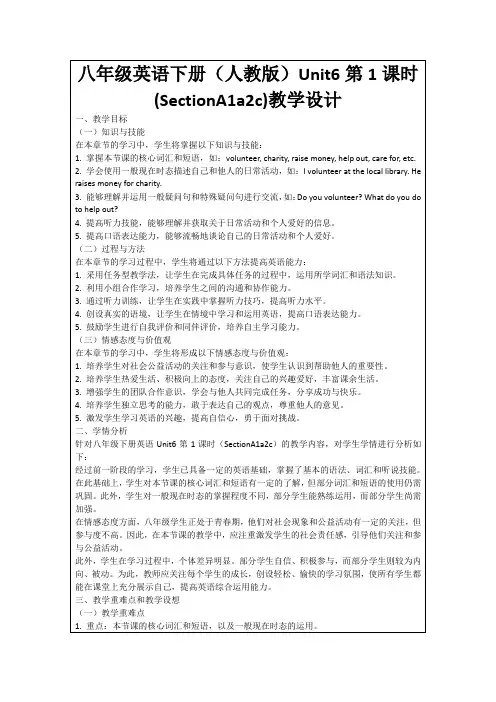
Unit6An old man tried to move the mountains.第一课时Section A(1a2d)【学习目标】1.重点单词:shoot,begin,god,remind,bit,silly2.重点短语:Journey to the West,Yu Gong Moves a Mountain,Hou Yi shoots the Suns,Nu Wa Repairs the Sky,once upon a time,instead of,work on,a little bit3.重点句式:An old man tried to move the mountains.How does the story begin?Where would they put all the earth and stone from the mountains?As soon as the man finished talking,Yu Gong said that his family could continue to move the mountains after he died.Finally,a god was so moved by Yu Gong that he sent two gods to take the mountains away.It doesn't seem very possible to move a mountain.The story is trying to show us that anything is possible if you work hard.Yu Gong kept trying and didn't give up.I think we should try to find other ways to solve a problem.What could Yu Gong do instead of moving the mountains?That's better and faster than moving a mountain!You have different opinions about the story,and neither of you are wrong.There are many sides to a story and many ways to understand it.【学习重点】1.重点短语和句型2.unless,so...that,as soon as...等的用法【学习难点】1.重点短语和句型2.unless,so...that,as soon as...等的用法【自学学习】一、预习课本P4142新单词并背诵,完成下面的汉译英。
人教英语八下Unit 6 An old man tried to move the mountains.整体单元设计一、语篇分析What:本单元围绕“传说故事”话题展开叙述,属于“人与社会”主题,社会文化与文学艺术子主题。
让学生了解中西方传说故事内容及表现形式,培养学生探索不同传说故事中的文化精神。
在Section A 部分呈现了中国民间神话,包含后羿射日,大闹天宫,女娲补天,愚公移山等。
通过听力活动,结合图片导入四个故事,并听取《愚公移山》这一故事的细节,完成简单语言输出。
之后在2a2c部分增加as soon as, but, so, finally等连词的教学,学生通过故事细节的了解,结合旧知,尝试开展故事讲述,并在最后就《愚公移山》故事展开讨论。
3a3c部分通过一篇有关西游记的篇章,引导学生理解大意和细节,并开展练习,回答问题。
Grammar环节通过疑问句及答句设置,引导学生巩固连词,故事写作逻辑顺序,细节内容提取及时态应用,为后续阅读和写作扎实基础。
Section B部分主要讲述西方童话故事,包含《皇帝的新装》和《糖果屋》,进一步拓展有关故事叙述的词汇和句法。
1a1d围绕《皇帝的新装》开展听力活动,通过听力了解故事情景,抓取关键信息,开展相应练习,并通过图片与听力结合进行故事输出。
在阅读板块,首先通过学生已知知识,谈论对睡美人,辛迪瑞拉,和小红帽三个童话故事的认识,然后开展《糖果屋》节选阅读活动,学习戏剧的形式,并设置了场景描述,提问的脚手架形式,再引导学生根据理解开展戏剧表演。
在最后的写作板块,设置了写作框架,让学生通过关键词填空完成写作。
Why:本单元选择“传说故事”主题,培养提升了解不同文化中的不同传说故事,有利于学生了解故事叙述方法,写作特点,同时培养学生探索不同故事底层的文化意义。
学生学习到愚公不畏艰险,不怕困难的精神,明白中国传统文化的博大,精深。
同时也接触到西方童话故事,思考不同文化下不同故事的表现形式和深层含义。
Unit 6 An old man tried to move the mountains. Period 3一、学习目标1) 学习掌握下列词汇:object, magic, stick, hide, tail, turn…into, excite, western 2)阅读短文,能按要求找到相应的信息。
3)通过阅读提高学生们的阅读能力。
4) 了解《西游记》中美into a person. the3)、Read the paragraph 2 and answer the question. Why is the story so popular in Western countries? 4)、Exercise. 3c. Complete the sentences below with phrases from the passage.5、Retell the story 1) 以小组为单位,互相说一说本篇课文都讲了些什么内容?五分钟时间。
2) Lucky ball 学生通过选择“幸运球”,进入自己所挑选的练习中,开始复述课文。
Step 3、Sum up What have you learned from this class? What can we learn from Monkey King? 1、We should be helpful to the weak. 2、We should never give up when we meet difficulties. Step 4、Homework 必做题:Finish the exercise book Uni标 1. 语言知识目标: 1) 能掌握以下单词:remind, bit, silly, ......Unit6An old man tried to move the mountains.教...新人教版八年级英语下册Unit6An old man tried to move the mountains.教案...Unit6An old mantried to moved the mountains. 一、教学目标: 1.知识......Unit6 An old man tried to move the mountains新版新目标八下教案Unit6An old man tried to move the mountains_初二英语_英语_初中教育_教育专区。
Unit 6 An old man tried to move the mountains Section A 3a—3c
Teaching plan
I. Teaching Goals
1. Knowledge Goals:
1) Key V ocabulary:object, magic, stick, hide, tail, turn…into, excite, western
2) Target Language:
The Monkey is the main character in the traditional Chinese book
Journey to the West.
The Monkey King can turn himself into different animals and objects.
He can not turn himself into a man unless he can hide his tail.
2. Ability Goals:
1). Be able to understand the passage and learn to talk about the Monkey King using the target language.
2). Enable students to practice reading and writing with the target language.
3). Train students' integrative and comprehensive abilities.
3. Emotional Goals:
Educate students to keep fighting against evils and bad deeds and never give up.
II. Key points and difficult points
1. Key Vocabulary:object, magic, stick, hide, tail, turn…into, excite, western
2. Key Expressions:
The Monkey is the main character in the traditional Chinese book Journey to the West.
The Monkey King can turn himself into different animals and objects.
He can not turn himself into a man unless he can hide his tail.
3. Difficult Points:
Be able to understand the fairy story and tell their favorite story with target language.
III. Teaching steps.
1. Greetings
2. Review: Do you know these traditional stories of China?
3. Watch a video
4. Talk about the four main characters especially the Monkey King.
5. How much do you know about the Monkey King?
6. Teach the new words by showing some pictures.
New words: hide—hid, turn…into, object, magic stick, tail, excite, western.
7. While reading: Task 1: Skimming
Read the passage quickly and finish answering the question and match
the main idea with each paragraph. They have two minutes. Question: Which book is talked about?
Match the main idea.
Paragraph 1 Western children are also becoming interested in the
stories of the Monkey King.
Paragraph 2 The Monkey King is new to pupils in England but not
to Chinese children.
Paragraph 3 The Monkey King is not just normal monkey. He can do magical things.
8. Check the answer.
9. While reading: Task 2: Careful reading.
Read paragraph 1 and tell T or F in two minutes.
1). In November 1978, pupils in England were able to watch a new TV program called Monkey. ()
2). Most of them were hearing this story for the second time. ()
3). The Monkey King is the main character in the traditional Chinese book Journey to the west. ()
Ask three students to tell their answers. If it is true, move to the next one, if it is false, ask the students to tell the correct answer. Then read the three sentences together.
10. Careful reading: Read paragraph 2 and finish the mind map. Time limit: 2 minutes.
11. Check the answer.
12. Read paragraph 3 and finish another mind map. Then check the answer.
13. Finish 3c. Check the answer after they finish it. Read these sentences together.
14. Game: House of card. (Optional)
1). Tell the rules of the game: Choose a card. If you are lucky enough you can get into the house directly and get some points. If you choose a number and you are asked to answer a question, then you have to answer it correctly to get some points. If you don't give the right answer, there will be no points for you. And if you give up, no points either.
2). Play the game.
15. Read the passage while listening. Pay attention to the pronunciation.
16. Discussion: What do you think of the Monkey King? What is he like? Ask Ss to talk about their own opinion freely.
17. Summary: We talk about the main character the Monkey King from Journey to the West. He can do many things, but he cannot turn himself into a man unless he can hide his tail. His spirit should be learned by children both from China and Western countries.
18. Homework: 1). Tell your family or classmates about the Monkey King in English. 2). Try to recite the passage.
Remember: Never give up and be helpful. Where there is a will, there is a
way.
19. Blackboard design.
Unit 6 An old man tried to move the mountains. Section A 33c
Words or expressions(Optional)
Evaluation System。